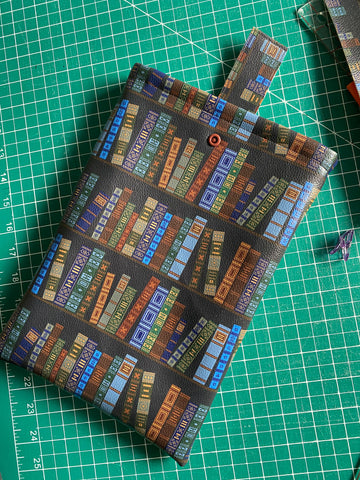Book Sleeve Tutorial

Oh hey there Book Lover!
Welcome to my first tutorial! As soon as I saw Ode to Shakespeare (from the September 2021 Preorder), I had envisioned the EXACT book sleeve I wanted to make but couldn’t find a pattern or tutorial ANYWHERE! Everything was JUST not right and didn't cover one made from Synthetic Leather/Vinyl, so here we are! If you like the style, but prefer to use Cotton Woven (Poplin, Canvas or Twill) as the outer material, I've added some notes to the bottom of the tutorial to make it this way too!
This tutorial is aiming for a book sleeve approximately 12.5” x 8.5” (give or take 1/2” to either dimension). My sleeve worked out to be a teeny bit under this but comfortably fits a large chunky book (tested with Weaveworld Hardcover, approx. 9.5” tall x 6.5” wide x 2.5” thick).
Ready? Here we go!

What you need:
- Sewing machine (obviously, but you won't need an overlocker/serger)
- Synthetic leather/Vinyl. 1 FQ is more than enough. You may get away with less. See cutting instructions below for piece sizes to be sure.
- Inner fabric (we will be using Solid Cotton Poplin in Wine for this tutorial). Canvas or Twill is also suitable. 1/2m is sufficient, but same as above, if you have less, see cutting instructions below for exact piece sizes.
- Something to push corners out. That Purple Thang is PERFECT! Consider this the encouragement you needed to finally get one if you haven’t already! Otherwise, a bodkin or chopstick will suffice.
- Fusible foam/fleece or Wadding/batting. I have used bamboo wadding because I had it on hand, but fusible fleece is preferable and will make it a lot easier. You must use fusible fleece if you don't have a walking foot.
- Pins and clips (yes you will need pins, clips alone won’t do for this one sorry!)
- Rotary cutter or Scissors
- Pinking shears (optional)
- Leather needles or Heavy Duty needles (HIGHLY recommended)
- Matching thread for both inner and outer fabrics
- Air erasable marker or chalk pen or chalk pencil. A washable marker won't work as you can't wash this product once it’s finished.
- A walking foot is very helpful, but not necessary. Use fusible fleece instead of wadding if you don’t have a walking foot.
- FOR SNAP AND STRAP CLOSURE:
- 1 KAM snap set (1x stud and cap + 1x socket and cap)
- Snap applicator/press
- Snap awl
- FOR BUTTON AND LOOP CLOSURE:
- Cord elastic, minimum 1/8” thickness. This is flexible, you will need minimum 6” (this is about the size of a hair elastic, so a thick hair elastic is perfect at a pinch), but if you have cord elastic, then 7-8” is ideal.
- 1x 20-25mm button (this is also flexible, but this will be the most ideal for the elastic length, I certainly wouldn't go any smaller)

Cutting instructions:
- 2x Outer pieces (Synthetic Leather): 13 ¼” tall x 9 ½” wide
- 1x Strap piece (Synthetic Leather): 7” tall x 1 ½” wide (strap closure only)
- 2x Inner pieces (Poplin): 13 ¼” tall x 9 ½” wide
- 2x Fusible fleece or Wadding/Batting: 14 ½” tall x 10 ½” wide

Sewing instructions:
Step 1:
Cut all pieces according to cutting instructions above.
Step 2:
Attach lining to padding. For Cotton Woven outer, jump to notes at end of tutorial.
- If using fusible fleece: Place poplin roughly in the centre of the fusible fleece pieces and apply to WRONG side of poplin according to the manufacturer’s instructions.
- If using wadding/batting: Place poplin roughly in the centre of wadding pieces and PIN in place starting from the centre and ensuring it is evenly pinned.

Step 3:
Mark quilting lines using a chalk pencil or air erasable marker. I marked two lines down the horizontal and vertical centre, then additional lines equally dispersed toward the edges. For this size, it worked out to be 5 vertical lines about 1.5” apart, and 7 horizontal lines 1.5” apart with a bit of extra space at the top and bottom, which works out well for this tutorial.
You may sew in whatever combination or line spacing you would like. You do not need to do both vertical and horizontal lines (or if you’re an avid quilter, go for gold with something fancy) as long as the pieces are evenly quilted. Keep in mind, for this version (SL outer, poplin inner) this piece will be on the inside of the sleeve so it’s not CRUCIAL that it looks even (unless you’re a total perfectionist).

Step 4:
QUILT! A walking foot is highly recommended if using wadding, it is also helpful but not necessary if using fusible fleece.
- Be sure not to sew past the lining pieces as you will be trimming the overhanging fusible fleece/wadding later.
- You may also like to gently wipe away your marking lines according to marker removal instructions after sewing/quilting. For Cotton Woven outer, jump to notes at end of tutorial.


Step 5:
Trim wadding/fusible fleece down to be the same size as your lining pieces (or outer pieces for the Cotton Woven option).

Note: your lining pieces may end up a touch smaller than your outer pieces once quilted. This is fine, as long as it's not the other way around and as long as the two lining pieces are the same, and the two outer pieces are the same.

Step 6:
FOR STRAP & SNAP CLOSURE (Skip to Step 7 for Button/Loop Closure, or jump to notes at end of tutorial for Cotton Woven option.):
a) Cut a 1.5” x 7” strip for the strap. Fold in half lengthwise with wrong sides together and edge stitch using a 1/8” SA. You may wish to use your rotary cutter or scissors to trim the edges down and clean them up if there are any uneven spots.
b) Align the raw edge of the strap with the top edge of one outer piece (or back outer piece if different or if you have cut a specific placement). Ensure it is centred and right sides together. Note, the side of the strap facing the right side of the outer piece, will the be side that shows on the front when the sleeve is closed. Baste in place.










Step 7:
FOR BUTTON AND ELASTIC CLOSURE (Skip to Step 8 if you've used the Strap/Snap Closure):
- Yellow markings on photos below represent the elastic. Take your elastic and place it at the centre-top of one outer piece (or back outer piece if different from front, or if you have cut a specific placement). The elastic must be against the RIGHT side of the fabric. Allow the elastic to overhang approximately 1/4” above the raw edge. Baste in place.
- Mark 1 ¾” down from the top-centre on the inside of one outer piece (whichever is the front if you’ve chosen a specific placement), cut a small scrap (a little under 1x1” is fine) of any fabric and place where you have marked, this will add stability to the fabric where the button will be sewn. Hand-sew a button to where you have marked through the outer piece (and scrap backing) only. Keep in mind this button will be a little strained from the elastic pulling to keep it closed so it must be attached very securely.


Step 8:
Place the lining pieces on top of the outer pieces, centred and right sides together. Clip or pin along the top edge (where the strap or elastic is placed for the back pieces, and the edge closest to the button or snap for the front pieces). Sew with a 1/4” seam allowance. I would also sew an extra line or two over the strap/elastic to give it a bit of reinforcement.

As mentioned earlier, your lining pieces may end up a bit touch smaller than your outer pieces once quilted. This is fine, as long as it's not the other way around and as long as the two lining pieces are the same, and the two outer pieces are the same.

Step 9:
Now you have two pieces. Open them and lay flat. I forgot this part on my own sleeve, but I highly recommend under-stitching the seam allowance to the lining pieces. This isn't crucial, but will make topstitching a little easier and neater. Place the two pieces, open flat, right sides together with lining against lining and outer against outer.
Clip or pin together all the way around leaving a 5” opening hole at the bottom of the lining pieces, a 3” hole will suffice if using a Poplin/Canvas outer. Sew with a 3/8” seam allowance starting and stopping at the turning hole.



Step 10:
Clip the corners, being careful not to clip your stitches. I also found it helpful to trim the seam allowance down to ¼” with pinking shears to reduce the bulk of the seams. You may use your rotary cutter or regular scissors for this step too. DO NOT TRIM YOUR TURNING HOLE. Keep this to a 3/8” allowance for when you close it up.


Step 11:
Turn the whole sleeve out via the 5” turning hole. The SL makes it a little tricky, so just be careful and take it slow. Gently push out all four corners using That Purple Thang (or Bodkin, or whichever tool you prefer to use).



Step 12:
Close up the turning hole by folding the seam allowance inwards and topstitching across (you may also hand sew using a ladder stitch if you prefer a more hidden seam.


Step 13:
Push the lining right down into the outer piece. Topstitch around the opening using a 1/2” - 3/4” seam allowance, I personally found the wider topstitching looked a lot nicer than the traditional narrower topstitching used on clothes.

Note: Be sure to push your lining inward (so that the outer fabric sits higher above the seam) as you topstitch. This will ensure the lining doesn't roll and show on the outer side. It will also be a touch easier if you chose to understitch in Step 9. If you opted out of understitching, no fear! I didn't understitch at all and managed by using clips to hold it down, and sewing slowly and carefully, pushing the lining under as I sewed (see below).


Step 14:
For Strap & Snap closure (skip to Step 15 for Button & Loop): Fold the strap down to overlap the front snap. You want the stud snap on the strap to be around 3/4” from the folded edge of the strap but use the socket on the front piece as a guide. Use an awl to pierce your snap stud placement and your chosen method of application to apply the stud to the strap. Ensure the stud is facing the correct way to be attached to the socket once the strap is folded over to close the sleeve.




Step 15:
Pop a book in your sleeve and close it up! YAY! You’re finished!


Bonus Bookmark
Oh! If you’re wanting to make a super easy bookmark with the scraps, I just sewed two long rectangles the size of a standard bookmark (or whatever dimensions you’d like) with a 1/4" seam allowance, wrong sides together, and trimmed them down to 1/8” to tidy them up. Simple!

Cotton Woven Outer
Alternative instructions for a Cotton Woven outer (Poplin, Canvas, Twill)
- What you need:
- 1/2m of your chosen Cotton Woven will suffice for both inner and outer. Check cutting instructions for piece dimensions if hoping to use less.
- You MUST use some form of fusible material for this option to stabilise the outer layers. Either use the fusible fleece OR use fusible interfacing if you’re opting for wadding/batting.
- Cutting (only differs for strap closure option):
- Strap cutting dimensions: 7” tall x 2” wide
- Scrap piece to reinforce button placement. 1x2” will suffice.
- Step 2: Place OUTER pieces roughly in the centre of the fusible fleece or interfacing and apply to WRONG side of fabric according to the manufacturer’s instructions. Proceed to Step 3 of main tutorial.
- Step 4: With the quilted section on the outside, it is important for this option that the quilting is neat & tidy. You may even wish to sew along the bookshelves to complement the print or calculate a perfectly even grid yourself. Proceed to Step 5 of main tutorial.
- Step 6: FOR STRAP & SNAP CLOSURE (Proceed to Step 7 of main tutorial for Button/Loop Closure):
- Fold strap in half lengthwise with RIGHT sides together. Place your reinforcement piece along the folded short edge of the strap (either side is fine). Sew along LONG edges using a ¼” seam allowance being sure to catch your reinforcement piece too.
- Turn and topstitch using a 1/8” seam allowance, leaving the raw short edge as is. Proceed to Step 6b of main tutorial and follow through.
Tutorial written by Keira Spencer

